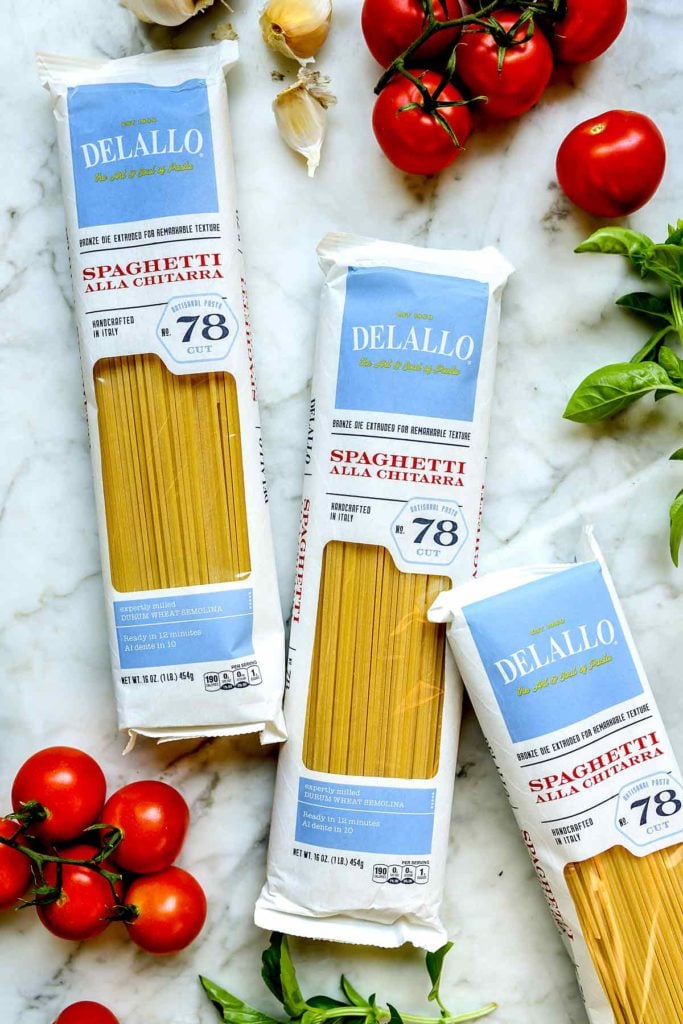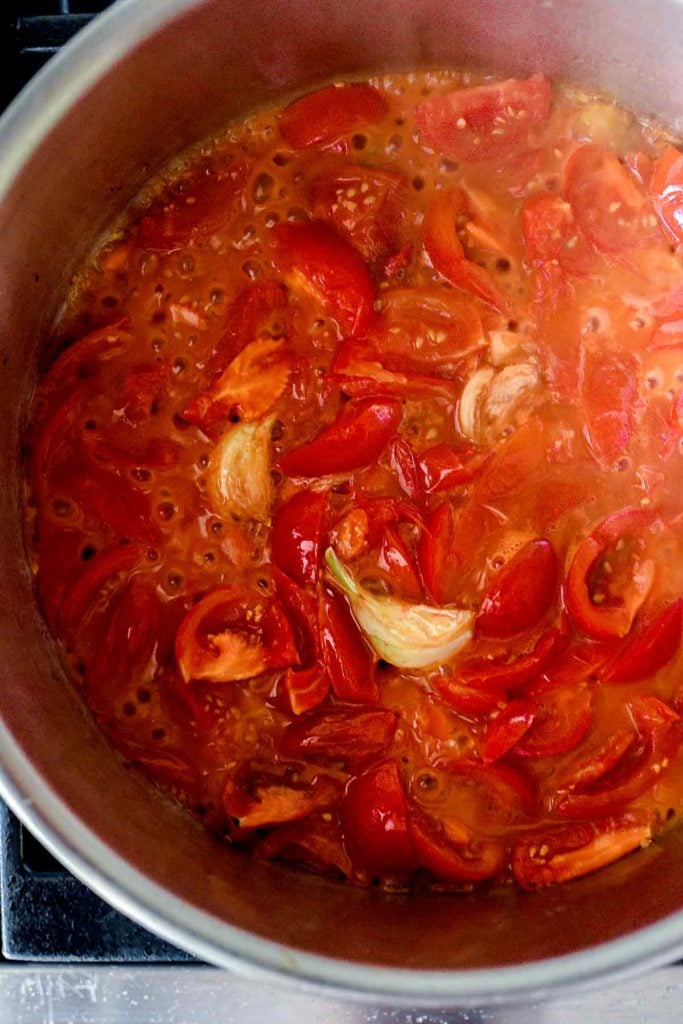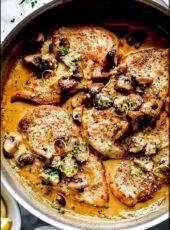A simple pasta topped with fresh tomato pomodoro sauce couldn’t be more authentically Italian, and like most things Italian, simplicity is key in this 5-ingredient recipe that’s ready in just 20 minutes.

This recipe is brought to you by DeLallo
Pinch me for sure, because I am lucky indeed. I recently visited the homeland of authentic Italian Pomodoro sauce, on the Amalfi Coast near Naples, Italy—the hub of authentic Italian pasta manufacturing and tomato farming. It was the trip of a lifetime, complete with amazing views of the dramatic coastal cliffs, white-knuckled winding roads I luckily didn’t have to chauffeur, so much amazing time with friends on the tour, and more real-deal authentic Italian food than I could dream of—so fresh and delicious I never wanted to leave. But why would I expect anything less? I was there with DeLallo Foods, a brand I’ve worked with for many years and shared many recipes using their products here on the blog, and who imports only the best ingredients directly from Italy to the U.S. We were in Italy to visit their pasta factory and learn more about what makes pasta made in the small southern city of Gragnano in the Campania region of Italy, the best, certifiably authentic pasta in the world—and the only way DeLallo produces their delicious Italian pasta. In addition to learning about how pasta is made, we took a cooking class and learned how to make this classic Pomodoro al Spaghetti from the chefs of the two-star Michelin-awarded restaurant Don Alfonso, where among all of their highly regarded recipes, this is their most popular recipe. It may have been the simplest meal we had on the trip and might be the reason it ended up being my favorite. I couldn’t wait to get home and master this classic Pomodoro sauce myself, and now, you’re about to as well.

In This Post
What is Pomodoro Sauce Made of?
Pomodoro is one of the most popular tomato-based sauces you’ll find in Italy. Because this Pomodoro sauce recipe is so incredibly simple, using only the best quality ingredients is key to its amazing taste. This recipe couldn’t be simpler and is just 5 ingredients. Here are the Pomodoro sauce ingredients you’ll need:
- Fresh tomatoes—in Italy they’re called Pomodorino Vesuviano, or grape or cherry tomatoes; no canned tomatoes here! Look for medium-sized tomatoes a little bigger than the size of a golf ball. You can usually find them labeled as cocktail Campari tomatoes.
- Garlic cloves—there’s no need to remove the papery skin from the whole cloves in this recipe
- Extra virgin olive oil—DeLillo’s olive oil is imported from Italy and reigns supreme
- Basil—fresh basil leaves are a must, tear them with your fingers so they don’t oxidize as they would when cutting with a knife
- Kosher salt—just two generous pinches bring out the sweetness in this sauce
Tip: For a little heat, add a pinch of red pepper flakes

What’s the Difference Between Marinara and Pomodoro Sauce?
Hailing from the Southern region of Italy, pomodoro and marinara sauce or pizza sauce are made with similar ingredients. They’re all best when made with fresh tomatoes (Naples is famous for its tomatoes) producing a fresh tomato flavor that takes just 20 minutes to make. Authentic Pomodoro sauce from Naples is always made with fresh tomatoes, but if you do need to use canned, look for authentic DOP imported tomatoes. Another difference is Pomodoro sauce is typically thicker, and marinara usually has other aromatics or fresh herbs added, like onions or oregano.

Made in Italy—DeLallo Pasta
After visiting both the mill where DeLallo’s wheat is ground (and grain has been milled since the 1200s) and the Gragnano factory where the wheat is turned into pasta, I had a whole new appreciation for the humble Italian noodle. Here are just a few reasons DeLallo pasta is head and shoulders above other brands you may find in the grocery store:
- DeLallo pasta is made following the strict guidelines of Pasta di Gragnano PGI and is produced in a legally defined territory defined by the king of Napoli two centuries ago. Only pasta in this area can note this distinction, which protects the quality of the product.
- DeLallo pasta is made from locally milled, higher protein durum wheat semolina flour mixed with water from the local aquifer in the Lattari Mountains. The pure water contains less calcium so it makes a more supple pasta, and the proximity to the sea produces perfect pasta-making humidity.
- DeLallo pasta adheres to the centuries-old custom of long drying times where pasta was dried in the streets of Gragnano under the sun. Now done conventionally to simulate the old drying tradition, DeLallo pasta has a natural drying time of 18 hours compared to some other commercial brands who bake their pasta for just four hours and use cheaper, lower protein flour.
- Bronze dies are another signature of authentic pasta. With over 200 different shapes of pasta that can be produced, DeLallo uses traditional bronze dies that are more expensive than the Teflon and plastic die used by large manufacturers to mass produce pasta faster, but not better.
- The result is DeLillo’s pasta is golden in color with a slightly rough texture creating the best flavor, texture, and taste. These cooked noodles hold and absorb pasta sauce whereas mass-manufactured types of pasta are slick and yellow with less nutritional value, and create a slippery noodle that sauce can’t cling to no matter how hard it tries.
In fact, get this: Some authorities like Dr. Mark Hyman say the simple cause of gluten intolerances can be attributed to pasta’s shorter drying times that are then quickly dried by baking at much higher temperatures (115°F vs. 75°F), modifying the product and its nutritional content.

How to Make Pomodoro Sauce
The method for making this pomodoro sauce couldn’t be easier and once you master it, you’ll find yourself making it all of the time for quick eats at lunch or dinner too. This recipe takes three large pans and is cooked in three steps. A few pasta pomodoro recipe cooking tips I learned from our cooking class: Step 1: You will need one large pot to cook the pasta. Cook the pasta just halfway, for just 5 minutes at a rolling boil in generously salted water. Start cooking the pasta before you start the sauce, which comes together quickly. *BIG NOTE: Reserve at least 1 to 1 ½ cups of the pasta water to add to step 3 where you will continue cooking the pasta in the garlic-flavored oil.

Step 2: You will need one large skillet to cook the Pomodoro sauce. Start by flavoring the hot oil with the whole garlic cloves over medium-high heat then add the quartered tomatoes to the oil with the cloves. There’s no need to mince or chop garlic in this recipe. Instead, use whole cloves with the paper on to flavor the oil as it heats. The paper helps protect the cloves from burning and becoming bitter and is removed from the sauce as it cooks. Note: Be careful of the sizzle. Cooking the tomatoes at this high temperature means the tomatoes won’t release as much liquid but become more creamy instead. Fish out the garlic cloves with cooking tongs, and use a wooden spatula to break down the tomatoes as they cook. Note: Tear basil leaves rather than cut them so they don’t oxidize, and add to the sauce to continue cooking while you finish with step 3.

Step 3: You will need one large skillet to toss the pasta with lightly garlicked goodness before adding to the sauce, which is the master secret to making this pomodoro pasta the most popular dish at 2-star Michelin-rated Don Alfonso. Repeat the same process as in step 1 and cook whole cloves in the extra virgin olive oil for flavor. CAREFULLY add small ladles of the pasta water (about ¼ cup at a time) to the garlic-infused oil so the oil and water don’t splatter and burn you. Fish out the pieces of garlic with tongs and add the pasta to continue cooking in the garlic-infused water for another 2-3 minutes or until al dente, stirring as it cooks.
VIDEO: How to Make Authentic Pomodoro Sauce
The video below is from our cooking class at Don Alfonso, complete with directions in Italian and some of my meager attempts at translation :).
How to Serve Pomodoro Sauce
For Italians, pasta is served at nearly every lunch meal, and pomodoro sauce with pasta is a favorite. Pomodoro sauce is simple and light and this recipe produces just enough to coat the cooked noodles, not drown them in it. The sauce is served simply over long pasta like DeLillo’s spaghetti or short pasta like penne. It can also be used as the base to many Italian dishes: layered lasagnas and eggplant Parmesan or chicken parmigiana, or my super easy gnocchi with pomodoro recipe, this versatile sauce goes with pretty much everything.
- You can get fancy with this recipe and plate individual portions, or keep it easy and serve it family style straight from the pan.
- To serve individually, twirl the noodles with tongs in a large ladle to create a nest. Place the noodles in a bowl and ladle with a ¼ to ⅓ cup sauce and garnish with fresh basil leaves.
- To serve family style, toss the sauce with the noodles, add more basil leaves, and have at it!
- And if you’re going to be authentic, resist the urge to add Parmesan cheese! It’s not the Southern Italian way :). But I mean, you do you.

Quick and Authentic Pasta Pomodoro Sauce
Ingredients
- 1 pound DeLallo dried pasta such as spaghetti or penne
- 1 pound medium size fresh tomatoes such as campari or cocktail tomatoes
- 6 tablespoons DeLallo extra virgin olive oil divided
- 6 large fresh garlic cloves of the same size, divided
- 12-15 basil leaves
- 1 ½ tablespoons kosher salt
Instructions
- Begin cooking the pasta noodles in boiling water seasoned with 1 tablespoon of kosher salt for approximately 5 minutes. *NOTE: Reserve 2 cups of the pasta water to add to the sauce later. While the pasta is cooking, start the sauce.
- For the sauce, cut the tomatoes in half, then quarter the halves, and set aside. Heat 3 tablespoons of extra virgin olive oil in a large sauté pan over medium-high heat, and add three of the garlic cloves to the oil. Tilt the pan so the garlic is immersed in the oil to flavor it as the garlic cooks. Cook until the garlic becomes fragrant and begins to color, then to avoid splatters, carefully add the tomatoes along with their juice to the flavored oil. Cook for 1-2 minutes, stirring and breaking apart the tomatoes as they cook. Pull out the garlic cloves and discard them. Continue cooking the sauce for 6-8 more minutes where it will thicken and become creamy as it cooks. Tear the fresh basil leaves into pieces and add to the sauce when cooking is nearly complete.
- As the pasta is cooking, heat the remaining olive oil in a large sauté pan over medium-high heat with the remaining garlic. Cook until lightly browned, remove the garlic and discard. Carefully ladle 1 to ½ cups of the pasta water ¼ cup at a time into the garlic-infused oil. Transfer the noodles to the pan and continue cooking the pasta for 1-2 more minutes or until the water and oil are absorbed. Divide the noodles among four plates, and top with the sauce. Garnish with more fresh basil and finish with a drizzle of extra virgin olive oil before serving. Or, toss the noodles with the sauce and serve family-style






